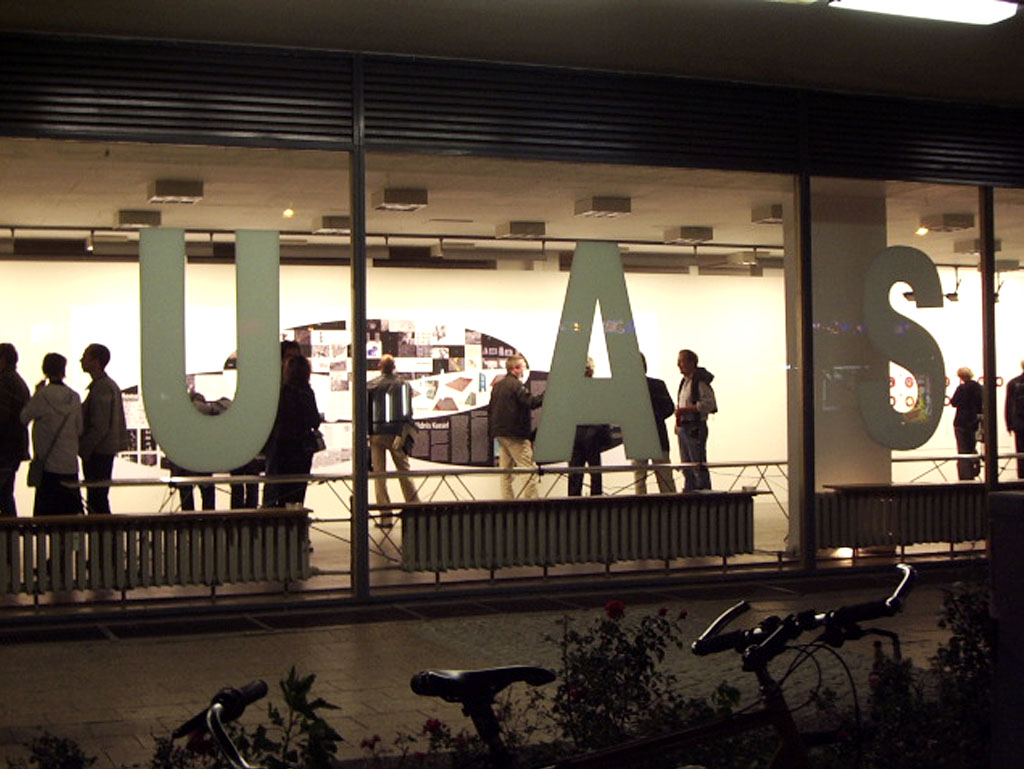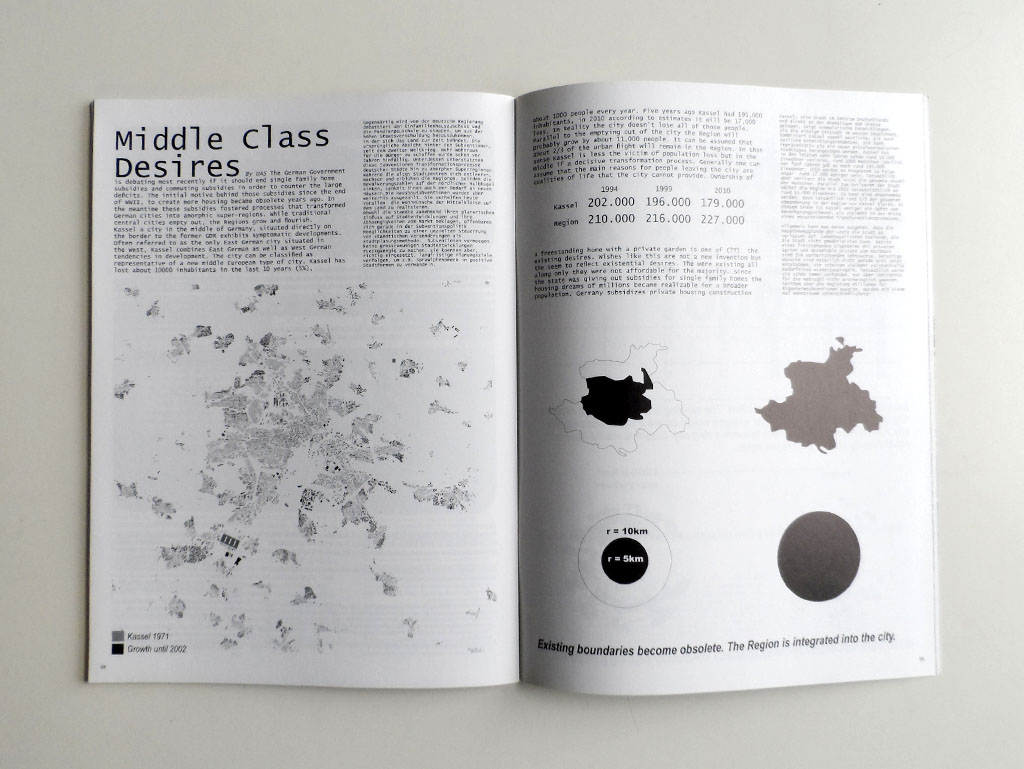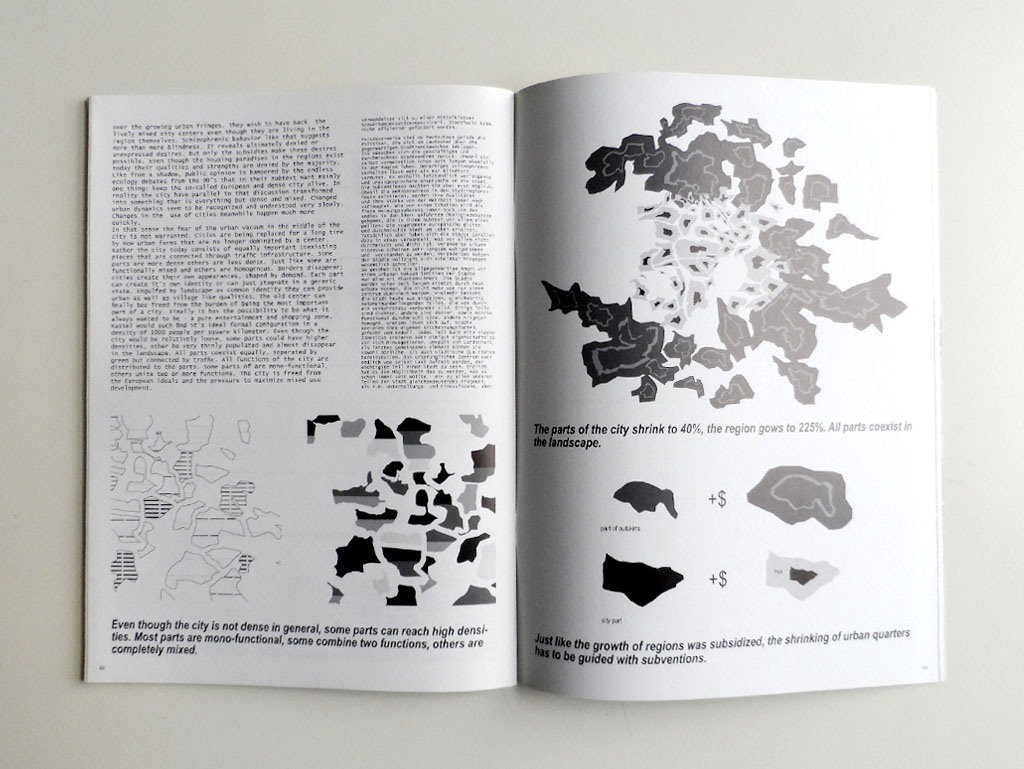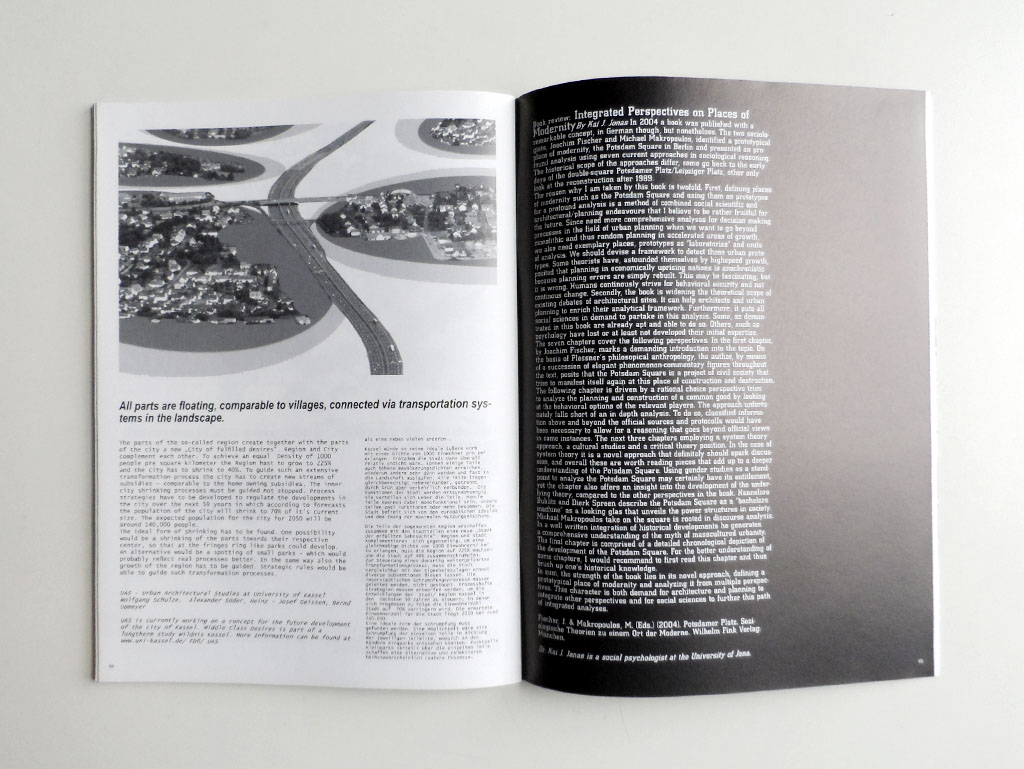11-04-05 // UNIVERSITY OF KASSEL

Exhibition of the “Wildnis Kassel” research project in the Framework Gallery in Berlin in August 2005
Bernd Upmeyer leads a research studio entitled “Wildnis Kassel” at the University Kassel in Germany. Some results of this studio are published in the article “Middle Class Desires” in MONU Magazine’s issue #2 on “Middle Classs Urbanism”.
“The German Government is debating most recently if it should end single family home subsidies and commuting subsidies in order to counter the large deficits. The initial motive behind those subsidies since the end of WWII, to create more housing became obsolete years ago. In the meantime these subsidies fostered processes that transformed German cities into amorphic super-regions. While traditional central cities empty out, the Regions grow and flourish.
Kassel, a city in the middle of Germany, situated directly on the border to the former GDR, exhibits symptomatic developments. Often referred to as the only East German city situated in the West, Kassel combines East German as well as West German tendencies in development. The city can be classified as representative of a new middle European type of city. Kassel has lost about 10000 inhabitants in the last 10 years (5%), about 1000 people every year. Five years ago Kassel had 195,000 inhabitants, in 2010 according to estimates it will be 17,000 less. In Reality the city doesn’t lose all of those people. Parallel to the emptying out of the city the Region will probably grow by about 11,000 people. It can be assumed that about 2/3 of the urban flight will remain in the Region. In that sense Kassel is less the victim of population loss but in the middle if a decisive transformation process. Generally one can assume that the main reasons for people leaving the city are qualities of life that the city cannot provide. Ownership of a freestanding home with a private garden is one of the existing desires. Wishes like this are not a new invention but they seem to reflect existential desires. They were existing all along only they were not affordable for the majority. Since the state was giving out subsidies for single family homes the housing dreams of millions became realizable for a broader population. Germany subsidizes private housing construction with up to 22,000 Euros per family. For the 11,000 people that will move into the Kassel region until 2010 the government will spend about 60,000,000 Euros if we assume 2 children families. Next to the housing subsidies, the commuting from the Region into the left-behind cities will be subsidized with a commuting-bonus. These traffic subventions transform into a luxurious city reminiscent tool. The emergency exit to the city is kept open and all fears to be cut off the city were muted. The initially socially motivated ideas developed into a middle-class tax- subsidy machine. Urban flight could not be subsidized more efficiently.
Paradoxically today it is politicians that complain the loudest over the growing urban fringes. They wish to have back the lively mixed city centers even though they are living in the region themselves. Schizophrenic behavior like that suggests more than mere blindness. IT reveals ultimately denied or unexpressed desires. But only the subsidies make these desires possible. Even though the housing paradises in the regions exist today their qualities and strengths are denied by the majority. Like from a shadow, public opinion is hampered by the endless ecology debates from the 90’s that in their subtext want mainly one thing: keep the so-called European and dense city alive. In reality the city have parallel to that discussion transformed into something that is everything but dense and mixed. Changed urban dynamics seem to be recognized and understood very slowly. Changes in the use of cities meanwhile happen much more quickly.
In that sense the fear of the urban vacuum in the middle of the city is not warranted. Cities are being replaced for a long time by new urban forms that are no longer dominated by a center. Rather the city today consists of equally important coexisting pieces that are connected through traffic infrastructure. Some parts are more dense others are less dense, just like some are functionally mixed and others are homogenous. Borders disappear; cities create their own appearances, shaped by demand. Each part can create its own identity or can just stagnate in a generic state. Engulfed by landscape as common identity they can provide urban as well as village like qualities. The old center can finally bee freed from the burden of being the most important part of a city. Finally it has the possibility to be what it always wanted to be – a pure entertainment and shopping zone.
Kassel would such find it’s ideal formal configuration in a density of 1000 people per square kilometer. Even though the city would be relatively loose, some parts could have higher densities, other be very thinly populated and almost disappear in the landscape. All parts coexist equally, separated by green but connected by traffic. All functions of the city are distributed to the parts. Some parts of are mono-functional, others unite two or more functions. The city is freed from the European ideals and the pressure to maximize mixed use development.
The parts of the so-called region create together with the parts of the city a new „City of fulfilled desires“. Region and City complement each other. To achieve an equal density of 1000 people pre square kilometer the Region hast to grow to 225% and the city has to shrink to 40%. To guide such an extensive transformation process the city has to create new streams of subsidies – comparable to the home owning subsidies. The inner city shrinking processes must be guided not stopped. Process strategies have to be developed to regulate the developments in the city over the next 50 years in which according to forecasts the population of the city will shrink to 70% of its current size. The expected population for the city for 2050 will be around 140,000 people.
The ideal form of shrinking has to be found. One possibility would be a shrinking of the parts towards their respective center, so that at the fringes ring like parks could develop. An alternative would be a spotting of small parks – which would probably reflect real processes better. In the same way also the growth of the region has to be guided. Strategic rules would be able to guide such transformation processes.”

Pages 58 and 59 of MONU’s issue #2

Pages 60 and 61

Pages 62 and 63

Page 64
Institution: University of Kassel
Course: Wildnis Kassel II
Department: Architecture, Urban Planning and Landscape Planning
Type: Research studio
Position: Assistant professor
Date: April 2005
Location: Kassel, Germany
Publication: MONU #2 – Middle Class Urbanism, pages: 58–64